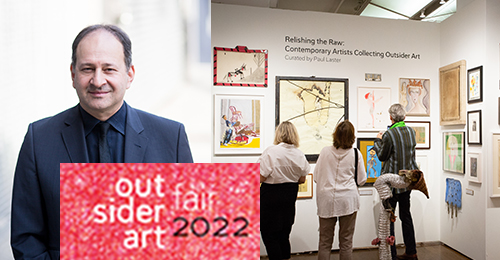
MAKING SENSE OF THE OUTSIDER ART PHENOMENON TODAY
Andrew Edlin is the founder and head of the New York gallery that bears his name. Founded in 2001, it has long specialized in the presentation of work by notable outsider and self-taught artists, including, among many others, Henry Darger, Thornton Dial, Sr., Eugene Von Bruenchenhein, Susan Te Kahurangi King, Domenico Zindato, Dan Miller, Melvin Way, Pearl Blauvelt, Marcel Storr, and Hans Krüsi. Over the past ten years, the gallery’s exhibition program has expanded to include the showing of the work of a number of schooled contemporary artists, too.

In 2012, Wide Open Arts, Edlin’s satellite company, acquired full ownership of the Outsider Art Fair from its previous owner, a company that had created that annual, New York-based event and produced it for two decades. The first edition of the fair produced by Wide Open Arts took place in 2013. The 2022 edition of OAF, which is scheduled to take place at the Metropolitan Pavilion in downtown Manhattan from Thursday, March 3, through Sunday, March 6, will be the tenth edition of the fair organized by Edlin’s company; it will also mark the 30th anniversary of the founding of this annual event.
In anticipation of this year’s fair, which will mark its return, in full physical, in-person form, following its presentation last year in a partly online, partly in-person hybrid form prompted by pandemic-lockdown constraints, I caught up with Edlin to speak about some of the discussions and developments that have characterized the outsider art field in recent years, not the least of which is the ongoing, indefatigable debate about whether or not the label “outsider art” should even be used.
This year, more than 60 exhibitors from the United States and overseas are expected to take part in the New York fair, pandemic conditions permitting.
by Edward M. Gómez
Edward M. Gómez for brutjournal: As the outsider art field continues to evolve, and as its history grows longer and ever more interesting and complex, what are some of the initiatives you’re undertaking to keep the Outsider Art Fair feeling timely, relevant, and fresh?
Andrew Edlin: In comparison with other fairs, the Outsider Art Fair is inherently renegade in spirit. It’s important to me that what we do should reflect that aspect of its history and identity. Last year, while COVID was raging, we were the first art fair to present five in-person exhibitions in addition to online viewing rooms. We have created a dynamic, alternative art-fair model, one in which one powerful exhibition can borrow works from a large swath of our exhibitors, offering them a novel opportunity to do business without the usual level of commitment to populating a booth, along with, for example, all of the shipping and accommodations expenses an individual booth entails.
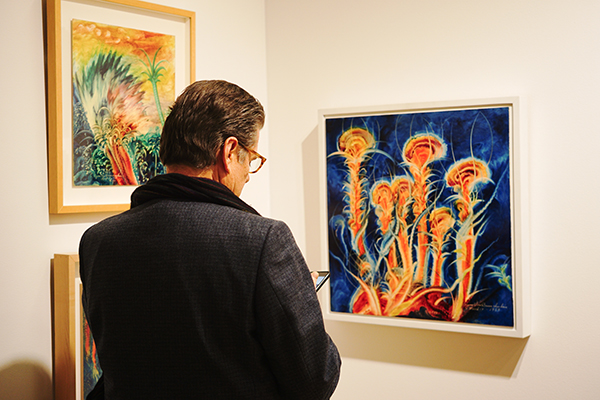
In October 2020, at the Outsider Art Fair Paris, the New York fair’s sister event, which we created after acquiring OAF, we accomplished this with the curator Alison Gingeras’s Sexual Personae exhibition, which was presented at Hôtel Drouot, the home of one of France’s well-known, venerable auction companies. In January of last year, as the pandemic was entering its second year, we pressed on with the fair by staging five curated exhibitions at different venues around Manhattan.
And last summer, in June, we upped the ante and produced Super-Rough, an exhibition guest-curated by the contemporary Japanese artist Takashi Murakami. That show, which was presented over a period of several weeks at a temporary space in SoHo, blew people away! We’ll continue staging such out-of-the box, OAF-branded exhibitions both inside and outside the confines of our regularly scheduled, physical fairs. Soon we’ll announce the appointment of a director who will be solely devoted to organizing the Paris fair, whose tenth edition will be presented in 2022.
advertisement

Edward M. Gómez: For some — or maybe for many — collectors, curators, educators, artists, art students, critics, art historians, and other admirers of outsider art, the use of that term to refer to the creations of non-academically trained art-makers who live and work on the margins of so-called mainstream culture and society or who might regard themselves as operating on or viewing the world from outside the mainstream is no big deal. As a category label, it serves to help guide one’s understanding of a particular kind of art.
For some other observers, the term “outsider art” appears to be some kind of bugaboo. They would argue that it is pejorative, derogatory, or discriminatory, in that it supposedly emerges from the assumption that the so-called mainstream (or “inside” of society, in general, and of the art world, in particular) is some kind of privileged realm (or “space,” in the jargon of postmodernist critical theory), and, therefore, that anything that transpires or that is produced outside that realm is inherently less valuable, less significant, or less worthy of serious attention.

In fact, the term “outsider art” has come to be used as a convenient umbrella term encompassing references to the related, overlapping categories of art brut, outsider art, and what Americans refer to as “self-taught art.” Each of these labels and the categories to which they refer are packed with nuances and distinctions.
In your case, not only does the Outsider Art Fair have an interest in the use of the term “outsider art,” but, as you have told me in the recent past, you also recognize the practical value of this label. It is both specific and broad enough to designate a particular, distinctive art phenomenon that, over the years, has been sliced and diced and referred to by various names.
Andrew Edlin: This is the topic that never seems to completely go away. I’ve always thought that “outsider art” is a term to which everyone seems to bring their own agenda. For me, “outsider” connotes non-conformity — having no regard for or knowledge of the rules (this is a good thing in art!). How is that not different from what a formal art education does to an artist? How much of what really makes art compelling can be taught?
“Art brut,“ “outsider,“ “self-taught“ — these terms have been used interchangeably. It has been 50 years since the British art historian Roger Cardinal came up with the term “outsider,“ and for the most part, nowadays, most people finally understand what we’re talking about when we use it. It’s part of the lexicon now, yet many writers still insert the modifier “so-called” in front of it, which is just an attempt to be non-committal or perhaps politically correct. Given the times we’re living in, maybe that’s understandable, if a little bit timid. One can put that disclaimer in front of anything, and it’s just as meaningless: a “so-called art critic“ or “so-called contemporary art,” for instance.
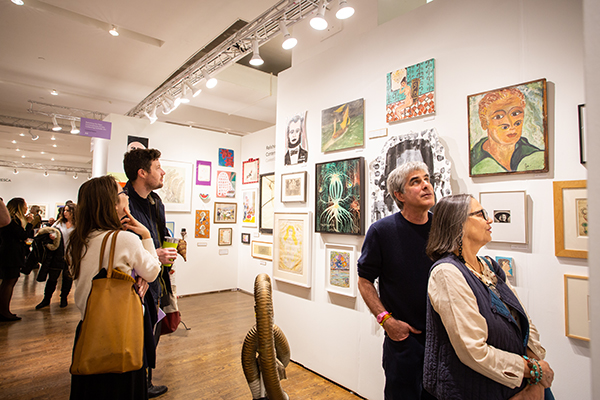
Others may feel that “outsider“ is an exclusionary term, one that deliberately sets a certain group of artists apart from the mainstream. I think that position comes from a sincere place and is partly aspirational, as if to suggest that not using the term “outsider“ might help open self-taught artists up to some kind of newfound acclaim.
The practical reality is that this is a distinct field of art; it was the one that recognized the accomplishments of singular artistic geniuses who did not fit into the canon that had been created by the academic art world. The designation “outsider art” provided a new place within the art establishment for the acceptance and belonging of such artists and their work where, before, none had existed.
Edward M. Gómez: Also, in practical terms, the label “outsider art” has some value in the art market, since, as you know as an experienced dealer, sometimes general labels help viewers to begin to comprehend whatever you might be presenting. Sometimes labels do not have to stick — or to be seen to stick — so indelibly. Sometimes, however limited or specific, they may serve to open doors of understanding. Also, keep in mind that a particular work of art may be described using more than one label at the same time. The meanings of some labels feel inherently expansive.
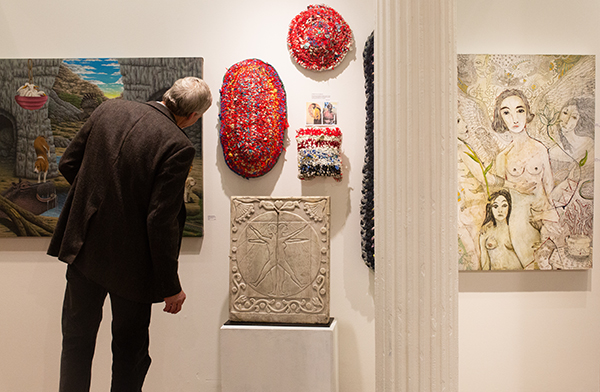
Andrew Edlin: It’s a platitude or a cliché to say there’s no such thing as outsider art, or that it’s all just art. Why use words like ”pop,” “minimalist,” “abstract,” or “conceptual?” Because they help people understand what they’re looking at. Without a laundry list of references and influences at hand as a guide, it becomes our challenge, as viewers, to decode or decipher a body of work that has only been discovered posthumously or perhaps made by someone who cannot even speak. To become comfortable with something that defies easy analysis — for me, that’s part of the thrill and mystery of art that also gives it power.
Then there are the detractors of the terms “outsider” and “outsider art” who are motivated primarily by money. They see the outsider designation as a barrier to higher prices, and in some cases even invent affinities between certain outsider works and contemporary art in order to justify raising their prices.
I’ve seen some blue-chip dealers try to contextualize outsider art in relation to certain forms of contemporary art and do so convincingly. But just as often, among certain others, one sees transparent attempts to force a round peg into a square hole. The result of that kind of effort is to dilute the force of the work, as if they are trying to say, “See, it’s not so different after all.“
[Editor’s note: In recent years, such galleries as Venus Over Manhattan, David Zwirner, and Barbara Gladstone, among others that are best known for showing star contemporary artists’ works, have begun showing the works of canonical outsider artists. Recently, Blum & Poe announced that it had become the official representative of Lonnie Holley and the Estate of Thornton Dial, Sr.]
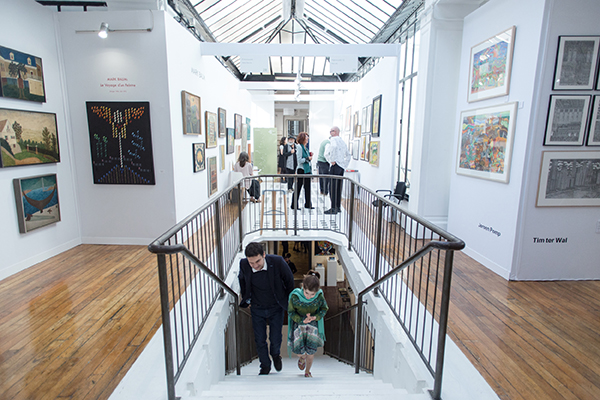
Edward M. Gómez: Speaking of well-known galleries that, in recent years, have begun showing work by certain notable, already critically recognized art brut or outsider artists, some observers in the art world might regard these developments as evidence that the mainstream art establishment has embraced and, therefore, has “legitimized“ outsider art.
Andrew Edlin: What does the showing by blue-chip galleries of high-quality outsider art signify? It would be easy to say that it’s about “validating” such art. But if we look more closely at this development, it becomes clear that many of the same forces that exist in the contemporary-art arena are at play here, too. Small to mid-size galleries either discover or get an artist’s work out into the market, and then, after it has gained traction both critically and with collectors, a big gallery may swoop in like a bird of prey and take over handling that artist’s work. The only protection a smaller gallery has is the good sense and, hopefully, the resources with which to purchase that rising-star artist’s work while it still has an opportunity to do so. Then it can participate in the upward trajectory in the market of that particular artist’s work.

It’s worth noting that virtually none of these galleries ever paid any attention to the works of self-taught artists until various dealers who have been associated with the Outsider Art Fair spent many decades advocating on behalf of such artists. In my view, this likens their businesses more to law or brokerage firms that are always hustling for new accounts. With their resources, collector lists, and expansive, high-profile gallery spaces, these galleries can make a strong case for higher prices, more museum exposure, and media attention.
Which is not to say that dealers like David Zwirner, Jeff Poe, or Adam Lindemann [of Venus Over Manhattan] don’t have a genuine respect and appreciation for the works of the self-taught artists they are now handling. I know for a fact that they do and I’ve seen them at our fair along with other prominent dealers, such as Jeffrey Deitch and Jeanne Greenberg.
Discovering and representing new outsider artists might not work for these dealers, given their economic models, and they may well be better off letting others do the heavy lifting at the beginning [of such artists’ art-market careers]. It’s up to the specialists to have the presence of mind and forethought to take bolder positions early on.
OAF dealers who know this world have an advantage; thanks to their connoisseurship and expertise, they’re nimble and finely attuned to new discoveries. As has been the case with the annual outsider-art sale at Christie’s, which takes place during the weekend of OAF, some blue-chip dealers have also been very successful getting this kind of work out to so many more collectors, who in turn can find works by the same artists within the OAF community.
This kind of activity pushes up secondary-market prices for everyone. So while some in our world may view this development as ominous, I see it as overwhelmingly positive. It’s a rising-tide-lifts-all-boats scenario.
Edward M. Gómez: We’ll see you soon in the big Outsider Art Fair boat that will be moored at the Metropolitan Pavilion, at 125 West 18th Street, in Chelsea, on Thursday, March 3, 2022, the date of the opening of this year’s fair!
Resources
Website of the Outsider Art Fair
https://www.outsiderartfair.com/
Website of Andrew Edlin Gallery
https://www.edlingallery.com/

